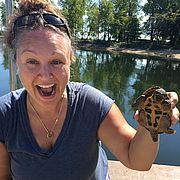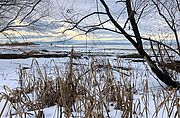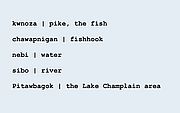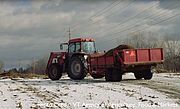At LCC we love science and water—and feel grateful to immerse ourselves in those topics every day. Click here to read the Vox article about the really cool science behind why soap and water is a killer combo in protecting us against Covid-19.
Read...News from Selected Category
As we all work to address the Covid-19 pandemic, keep in mind that wipes clog pipes, even if they are marketed as “flushable.” Click here to read the New York Times article about backed-up sewer lines in the wake of the coronavirus.
Read...Over the next few weeks, our friends at Lake Champlain Sea Grant are hosting "Zoom a Scientist," an interactive, virtual webinar series focused on watershed and aquatic science. The programs will feature scientists from the University of Vermont Rubenstein Ecosystem Science Laboratory, SUNY Plattsburgh, the Lake Champlain Research Institute, and other organizations. Every Tuesday and Friday from noon until 1:00 p.m. scientists will lead viewers through the Lake Champlain watershed and share their research.
Read...Deserted dog doo is a nasty addition to the bottom of an innocent passersby’s shoe—and to Lake Champlain. Canine feces left on hard surfaces like a sidewalk or compacted soil can wash into storm drains during any precipitation event. From there, they enter streams or the lake, which nearly 200,000 people rely on for their drinking water. Most pet owners conscientiously clean-up after their dogs, but those who don’t create an issue for people and waterways.
Read...As we physically distance ourselves from each other and try to flatten the curve for Covid-19 infection, getting outside every day will help bring solace and soothe spirits. Click here to read an article on the Seven Days website about three spots you can explore along Lake Champlain.
Read...Know a K through 12 student, teacher or homeschooler in the Lake Champlain Basin? In honor of World Water Day, LCC and Champlain Basin Education Initiative (CBEI) partners are hosting our annual cool contest to celebrate water. It’s a great way for educators to integrate art and science with their students.
Read...LCC seeks boating pictures to enhance our 2020 edition of the Paddlers’ Trail guidebook. If you ventured out on the water with a camera, please consider sharing some photos with us. We are looking for images of human-powered adventures on Lake Champlain and any discoveries made along the way. Scenes of paddling with friends (all wearing PFDs of course), packing your gear, fishing from your boat, and other visual reflections of water outings are welcome.
Read...If your faucet drips or your toilet runs it can waste over 10,000 gallons a year ― the amount of water in a typical backyard swimming pool. More than one trillion gallons of water are lost annually in the U.S. due to easy-to-fix household leaks.
Read...The plastic bag ban in New York State begins Sunday, March 1, 2020! Whether floating on a local waterway or stuck in a tree, plastic bags are a too common sight and blight on the landscape and in the water. Do your part to reduce plastic pollution and bring your own bag from the start.
Read...The Lake Champlain Committee (LCC) is no stranger to defending Vermont’s clean water laws. In December 2019, LCC was part of a coalition of environmental organizations that issued a press release on the unlawful emergency exemptions for farm manure spreading that result in pollution discharges into nearby waters.
Read...Arctic char, closely related to lake and brook trout, are a relic of the last Ice Age. When glaciers in New England receded between 10,000 and 12,000 years ago, the char colonized areas of inland New England. Other than Alaska, Maine is the only state with native Arctic char populations. This species occupies an array of aquatic habitats, from open oceans to inland rivers, throughout its geographic range.
Read...Photosynthetic bacteria, gelatin, and concrete are the building blocks of a new type of material: living concrete! Researchers at the University of Colorado, Boulder, funded by the Department of Defense, formed the new substance. Minerals in the concrete are deposited by cyanobacteria; in contrast to the typical greenhouse gas-emitting process required in the production of regular concrete, cyanobacteria absorb carbon dioxide through the photosynthetic process.
Read...As the seas rise higher, low lying islands and coastal areas are continually threatened by floods. Batasan, an island in the Philippines, is no exception. In 2013, a major earthquake (7.2 magnitude) hit the island, causing it to collapse downward.
Read...The Vermont Global Warming Solutions Act (GWSA - H.688) will be on the House floor tomorrow, February 20 for a crucial vote. The bill sets binding targets and holds the state accountable to develop and implement a plan to meet Vermont’s commitment to the Paris Climate Accord by 2025 and achieve net-zero carbon emissions by 2050.
Read...Recognizing that climate change poses an existential threat to Lake Champlain water quality, LCC was among 30 diverse organizations to present a policy plan of action to Vermont leaders in January. Since 2006, the state has had statutory goals to cut carbon pollution but we are very far from meeting them. Vermont is falling behind its Northeast neighbors in making pollution reductions, in part because the state lacks requirements to do so.
Read...Earlier this month Jared Carpenter, LCC’s Water Protection Advocate, joined with colleagues from the Vermont Conservation Voters, Vermont Natural Resource Council and other organizations to present the 2020 Environmental Common Agenda. The Common Agenda represents priorities of environmental groups across Vermont who are working to engage policy makers and citizens on important issues that affect water, air, land, wildlife, communities and health.
Read...In July 2019, LCC welcomed Lauren Sopher to the staff as our Director of Science and Water Programs. Lauren grew up in Vermont traipsing after frogs and toads along Monroe Brook, paddling the LaPlatte River, and exploring Lake Champlain’s surface and shorelines.
Read...A grant from outdoor gear co-op REI will enable LCC to purchase signage for Lake Champlain Paddlers’ Trail sites, update website content, and produce informational materials about the Trail. The funds will also cover a touring kayak and related gear for LCC field programs. “This REI grant will help us publicize the Trail, re-sign locations and upgrade our equipment,” notes LCC Executive Director Lori Fisher. “We’re grateful for the support to advance our stewardship.” REI will also be partnering with LCC on April Stools’ Day and aquatic invasive species assessments.
Read...Lakeshore and grassland are like yin and yang: seemingly opposite forces that are complimentary. The lakeshore provides water disturbance to the grass and the grassland provides shoreline stabilization to the lake—both processes shape this natural system.
Read...Every space gets dirty. Whether at home, at work, or somewhere in between, most of us use cleaning products on a regular basis to tidy up. While commercial products may get things squeaky clean, they can also do more harm than good. Many contain ingredients that can be acutely toxic; carcinogenic or mutagenic; irritating to skin, eyes or lungs; non-biodegradable; poisonous to aquatic organisms; or water and air polluting. Some common components of store bought cleaners to watch out for include ammonium, formaldehyde, glycol ethers, sodium borate, sodium laureth sulfates along with artificial colors, dyes and fragrances.
Read...Plant identification is not restricted to a particular season. Though woody plants can be difficult to identify in winter, the activity adds a new dynamic to winter adventures and is a fun challenge. Read on for identification tips about two common wetland shrub species, speckled alder (Alnus incana) and red-osier dogwood (Swida sericea), along with their value and role in wetland ecology.
Read...There is great potential behind a hole in the ice. On Lake Champlain, those holes are often related to ice fishing. You can make ice fishing what you want it to be: a social or solo activity, over a short or long timespan, and on open ice or under the cover of a shanty. No matter the approach, it’s an activity that gets folks outside and interacting with the natural world in the wintertime.
Read...In partnership with Jesse Bowman Bruchac, a Nulhegan Abenaki citizen and a teacher of the Abenaki language, the Middlebury Language Schools is launching a pilot School of Abenaki in summer 2020. Native to New England and Quebec, the Abenaki language is considered endangered.
Read...Beavers are active year-round. Explore what a beaver lodge and dam is like in the wintertime with conservation biologist, Steve Faccio, and Outdoor Radio co-hosts, Kent McFarland and Sarah Zahendra, at a frozen beaver pond in Pomfret, VT. From huddling together in lodges to storing their winter stash of food in the snow, you’ll learn about how North America’s largest rodent faces winter.
Read...A coalition of Environmental organizations—the Lake Champlain Committee (LCC), Conservation Law Foundation (CLF), Vermont Natural Resources Council (VNRC), and Vermont Audubon—issued a water quality-related press release on December 13, 2019.
Read...Protecting wetlands is a longstanding priority for the Lake Champlain Committee (LCC). The areas of interface between shoreland and water are a vital part of Lake Champlain’s ecosystem. Thank you for using your voice to protect Vermont’s wetlands now and into the future by contacting our legislators! We need a modern goal of a net gain in acres of wetlands through protection and restoration.
Read...In early September, Lake Champlain Basin Program Boat (LCBP) Launch Steward Matthew Gorton was conducting a routine boat inspection for invasive species prevention at a public access site in South Hero, Vermont when he noticed an unusual plant hanging off a boat trailer backing into the lake.
Read...Eight years ago last April 13, Lake Champlain reached flood stage (100 feet) and stayed above that level for a record-setting 67 days. Waters rose to 103.27 feet – the highest the lake has been since records have been kept. Lakeside homes, roads and buildings were inundated and battered by wind-driven waves. Then, on August 28, 2011 Tropical Storm Irene slammed into the Champlain Valley. Up to 11 inches of rain fell in the mountains; rivers swelled and flooded; homes, roads and bridges were wiped away.
Read...December 3 is Giving Tuesday, the "Black Friday" for charitable giving and part of an international movement to create a day of giving back. Please consider participating by making a gift of time or money to the Lake Champlain Committee.
Read...Hundreds of LCC-trained volunteers took to the water from mid-June through mid-November to assess conditions at more than 100 Lake Champlain and inland waterway sites. Each week they scoured the shoreline for signs of cyanobacteria, donned gloves and took water samples and faithfully filed online reports.
Read...





























